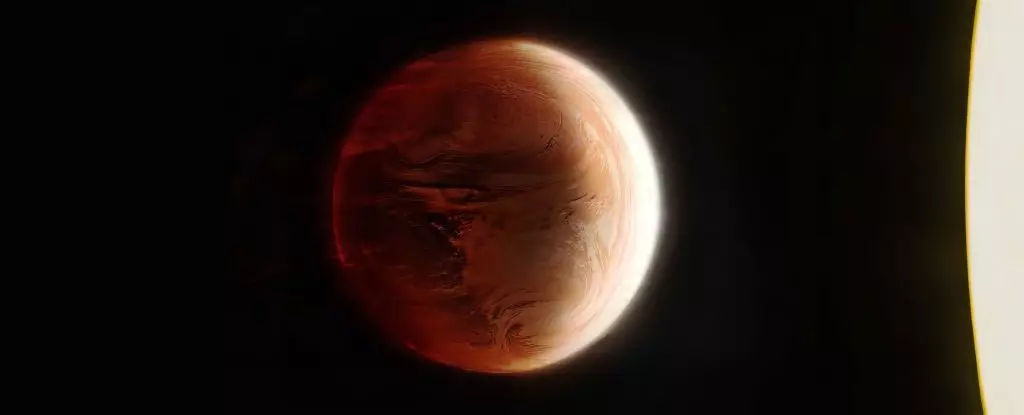In the ever-expanding universe of exoplanetary science, Tylos (WASP-121b) stands out as a remarkable example of an extreme world far beyond our Solar System. Located approximately 880 light-years away, Tylos presents conditions that seem plucked straight from a science fiction narrative—an atmosphere thick with clouds of vaporized metals, and a climate that showcases the fastest winds known to humanity. The study of Tylos offers insights that challenge existing meteorological models, presenting an opportunity to expand our understanding of weather patterns not just on Earth but across varying planetary bodies.
Tylos is classified as a “hot Jupiter,” a term that describes a category of exoplanets characterized by their Jupiter-like size but situated incredibly close to their parent stars, which results in extreme temperatures. This particular exoplanet is notable for being about 1.74 times the radius and 1.16 times the mass of Jupiter, while orbiting at such a proximity to its yellow-white F-type star, Dilmun, that it completes an entire revolution in just 30 hours. This accelerated orbital period leads to an astronomical equilibrium temperature of a blistering 2,360 Kelvin—far exceeding what some stars maintain.
The intense gravitational and thermal forces at play mean Tylos is experiencing atmospheric loss; its gaseous envelope is literally being stripped away into the void of space. As scientists study Tylos’ atmosphere, they find themselves piecing together clues about the composition and behavior of this alien environment, revealing a fusion of chemistry and cosmology that intrigues researchers from multiple scientific fields.
Astrophysicist Julia Victoria Seidel from the European Southern Observatory, along with her colleagues, recently achieved a remarkable feat—reconstructing Tylos’ atmosphere in three dimensions. Through their intricate observations, they discovered that not only does Tylos boast a rapid jet stream transporting clouds of metallic particles, but its wind dynamics also reveal severe vertical circulation patterns that transport energy deep into the atmosphere. As Seidel articulates, the atmospheric behavior observed on Tylos poses a significant challenge to our understanding of meteorological phenomena.
The findings allude to a dynamic jet stream traveling at astonishing speeds—initial observations indicated speeds of 13.7 kilometers per second, which dramatically increased to 26.8 kilometers per second in the evening, making it the fastest atmospheric current documented thus far. This rapidity highlights the impact of tidal locking on Tylos, with one hemisphere perpetually exposed to its sun’s ferocious heat, creating stark temperature differentials and consequently, stirring powerful winds throughout the planet’s atmosphere.
Tylos’ atmosphere is an intricate tapestry woven from various elements and compounds that interact in unusual ways. Initial assessments reveal a super-rotating wind flow enriched with clouds of iron and titanium that swirl more quickly than the planet itself can revolve. These conditions set the stage for a complex atmospheric layering: beneath the jet stream of metals, there exists a lower system transporting gas from the intensely heated day side to the comparatively cooler night side—a phenomenon unprecedented in planetary science.
Furthermore, the existence of high-temperature gradients causes dramatic weather shifts, with researchers identifying atmospheric layers replete with sodium and hydrogen, the latter of which is gradually escaping into space. This atmospheric activity showcases a climate unlike any known in our Solar System and presents an opportunity to deepen our understanding of not just Tylos, but the broader spectrum of planetary meteorology.
The study of Tylos symbolizes a significant leap forward in exoplanetary research, paving the way for more profound investigations into the atmospheric characteristics of distant worlds. As noted by Bibiana Prinoth of Lund University, the ability to discern complex details concerning chemical compositions and weather patterns of such remote planets is indeed remarkable. The intricate dynamics present on Tylos not only enhance our comprehension of exoplanet climates but also serve as a fertile ground for posing new questions regarding the behavior of atmospheres across contrasting worlds.
Understanding the many diverse climates of exoplanets such as Tylos will undoubtedly enrich both planetary science and our knowledge of the universe. As telescopes become increasingly sophisticated, the mysteries of other worlds will unravel, enlightening our grasp of the cosmos while expanding our perspective on the very nature of existence beyond Earth. The tale of Tylos, with its dramatic and tempestuous climate, reminds us just how fascinating—and bizarre—the universe can be.

